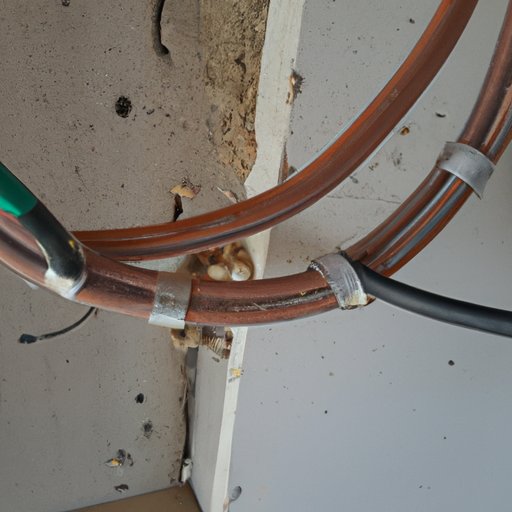Introduction
While aluminum wiring was once prevalent in homes, it has come with potential safety risks and concerns. With advances in technology and changes to building codes, the use of aluminum wiring has decreased, but it remains an issue for some homeowners.
In this article, we aim to provide an overview of the history and safety concerns of aluminum wiring, the current state of building codes and compliance requirements, and how homeowners can assess and address any issues they may have with aging aluminum wiring in their homes.
Historical Perspective
In the mid-20th century, increasing demand for electricity and copper shortages led to the adoption of aluminum wiring in the United States. It was cheaper than copper wiring, lighter in weight, and easier to install.
However, it soon became apparent that aluminum wiring had limitations and posed potential safety risks. Copper wiring was eventually deemed safer due to its better conductivity and non-corrosive properties.
While the transition from aluminum to copper wiring began in the 1970s, it took several decades to complete. Many homes built during the 60s and 70s still have aluminum wiring, and it continues to pose potential hazards.
Safety Concerns
One of the most significant safety concerns of aluminum wiring is its tendency to overheat, leading to potential fire hazards. When aluminum wire is overstressed or overloaded, the connections can become damaged or corroded, causing resistance and heat buildup.
Another safety concern is the risk of electrical arcing caused by loose connections due to aluminum’s softness. Arcing can cause sparking, fires, and potentially fatal electrocution.
To address these concerns, the industry developed new aluminum alloys that improve conductivity, durability, and resistance to corrosion. The use of aluminum-to-copper connectors, sometimes referred to as “pigtails,” also reduced the risks associated with aluminum wiring.
However, there is still ongoing debate over the safety of aluminum wiring, and homeowners with aluminum wiring in their homes should consider consulting with a licensed electrician to assess any potential risks.
Code Compliance
Building codes have changed over the years to require the phasing out of aluminum wiring due to its safety concerns. In 1972, the Consumer Product Safety Commission (CPSC) released a report warning of the dangers of aluminum wiring, leading to changes in the National Electric Code (NEC) to ensure the proper installation of aluminum wiring and its use with compatible outlets, switches, and breakers.
In the 1990s, the NEC required that aluminum wiring be used only for specific applications and with specific devices. These changes made copper wiring the industry standard for residential electrical work, and most new homes built today use copper wiring.
While aluminum wiring is still allowed under certain circumstances, builders must follow strict installation guidelines and codes to ensure safety compliance. Homeowners with aluminum wiring in their homes should consider having it inspected and upgraded to meet current safety standards.
Issues with Aging Wiring
Over time, aluminum wiring can become brittle and corroded, leading to potential hazards. The age of the wiring, the quality of installation, and exposure to moisture, heat, and other environmental factors can all contribute to problems with aluminum wiring.
Homeowners with aluminum wiring should be aware of potential problems and regularly inspect their wiring for signs of damage, including flickering lights, warm switches or outlets, or a burning smell. If any issues are discovered, homeowners should consider upgrading their wiring or rewiring their entire home.
While upgrading the wiring involves adding connectors to the existing wiring to address issues, rewiring involves fully replacing the wiring in a home. While rewiring can be more expensive, it provides a more comprehensive solution that can help homeowners avoid potential hazards and ensure compliance with current safety standards.
Professional Opinions
Electricians and industry experts have differing opinions on the safety and efficacy of aluminum wiring. Some argue that properly installed and maintained aluminum wiring is safe, while others recommend upgrading or rewiring to avoid potential hazards.
Ultimately, the decision to upgrade or rewire should be based on the age and condition of the wiring, local building codes, and the homeowner’s budget and priorities. Consulting with a licensed electrician can help homeowners assess the best course of action for their home.
Awareness Campaigns
In recent years, public awareness campaigns have aimed to educate homeowners on the risks associated with aluminum wiring and how to identify it in their homes. These initiatives have included online resources, media campaigns, and community events.
While these programs have helped raise awareness, homeowners should remain vigilant and proactive in assessing and addressing any potential hazards associated with aluminum wiring.
Conclusion
Aluminum wiring was once a popular choice for electrical wiring in homes, but safety concerns have led to a shift towards copper wiring and increased regulation. Homeowners with aluminum wiring should be aware of potential issues and consider upgrading or rewiring to ensure compliance with current safety standards and minimize the risk of hazards.
Consulting with a licensed electrician can help homeowners assess the best course of action for their home, and awareness campaigns can help educate homeowners on the risks associated with aluminum wiring.

